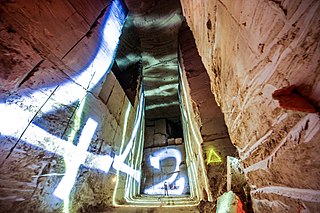
A camera is an optical instrument that captures images. Most cameras can capture 2D images, while some more advanced models can capture 3D images. At a basic level, most cameras consist of a sealed box, with a small hole that allows light to pass through and capture an image on a light-sensitive surface. Cameras have various mechanisms to control how light falls onto the light-sensitive surface, including lenses that focus the light and a shutter that determines the amount of time the photosensitive surface is exposed to the light.

In photography, shutter speed or exposure time is the length of time that the film or digital sensor inside the camera is exposed to light when taking a photograph. The amount of light that reaches the film or image sensor is proportional to the exposure time. 1⁄500 of a second will let half as much light in as 1⁄250.

A flash is a device used in photography that produces a brief burst of light at a color temperature of about 5500 K to help illuminate a scene. A major purpose of a flash is to illuminate a dark scene. Other uses are capturing quickly moving objects or changing the quality of light. Flash refers either to the flash of light itself or to the electronic flash unit discharging the light. Most current flash units are electronic, having evolved from single-use flashbulbs and flammable powders. Modern cameras often activate flash units automatically.
In photography, bracketing is the general technique of taking several shots of the same subject using different camera settings. Bracketing is useful and often recommended in situations that make it difficult to obtain a satisfactory image with a single shot, especially when a small variation in exposure parameters has a comparatively large effect on the resulting image. Given the time it takes to accomplish multiple shots, it is typically, but not always, used for static subjects. Autobracketing is a feature of many modern cameras. When set, it will automatically take several bracketed shots, rather than the photographer altering the settings by hand between each shot.

A monopod, also called a unipod, is a single staff or pole used to help support cameras, binoculars, rifles or other precision instruments in the field.
The science of photography is the use of chemistry and physics in all aspects of photography. This applies to the camera, its lenses, physical operation of the camera, electronic camera internals, and the process of developing film in order to take and develop pictures properly.

Time-lapse photography is a technique in which the frequency at which film frames are captured is much lower than the frequency used to view the sequence. When played at normal speed, time appears to be moving faster and thus lapsing. For example, an image of a scene may be captured at 1 frame per second but then played back at 30 frames per second; the result is an apparent 30 times speed increase. Similarly, film can also be played at a much lower rate than at which it was captured, which slows down an otherwise fast action, as in slow motion or high-speed photography.

Aperture priority, often abbreviated A or Av on a camera mode dial, is a mode on some cameras that allows the user to set a specific aperture value (f-number) while the camera selects a shutter speed to match it that will result in proper exposure based on the lighting conditions as measured by the camera's light meter. This is different from manual mode, where the user must decide both values, shutter priority where the user picks a shutter speed with the camera selecting an appropriate aperture, or program mode where the camera selects both.

A snapshot is a photograph that is "shot" spontaneously and quickly, most often without artistic or journalistic intent and usually made with a relatively cheap and compact camera.

Digital photography uses cameras containing arrays of electronic photodetectors interfaced to an analog-to-digital converter (ADC) to produce images focused by a lens, as opposed to an exposure on photographic film. The digitized image is stored as a computer file ready for further digital processing, viewing, electronic publishing, or digital printing. It is a form of digital imaging based on gathering visible light.

Light painting, painting with light,light drawing, or light art performance photography are terms that describe photographic techniques of moving a light source while taking a long-exposure photograph, either to illuminate a subject or space, or to shine light at the camera to 'draw', or by moving the camera itself during exposure of light sources. Practiced since the 1880s, the technique is used for both scientific and artistic purposes, as well as in commercial photography.
The following outline is provided as an overview of and topical guide to photography:

Sports photography refers to the genre of photography that covers all types of sports.

Banquet photography is the photography of large groups of people, typically in a banquet setting such as a hotel or club banquet room, with the objective of commemorating an event. Clubs, associations, unions, circuses and debutante balls have all been captured by banquet photographers.

Long-exposure, time-exposure, or slow-shutter photography involves using a long-duration shutter speed to sharply capture the stationary elements of images while blurring, smearing, or obscuring the moving elements. Long-exposure photography captures one element that conventional photography does not: an extended period of time.

Landscape photography shows the spaces within the world, sometimes vast and unending, but other times microscopic. Landscape photographs typically capture the presence of nature but can also focus on man-made features or disturbances of landscapes. Landscape photography is done for a variety of reasons. Perhaps the most common is to recall a personal observation or experience while in the outdoors, especially when traveling. Others pursue it particularly as an outdoor lifestyle, to be involved with nature and the elements, some as an escape from the artificial world.

A unit still photographer, or simply a still photographer, is a person who creates film stills, still photographic images specifically intended for use in the marketing and publicity of feature films in the motion picture industry and network television productions. Besides creating photographs for the promotion of a film, the still photographer contributes daily to the filming process by creating set stills. With these, the photographer is careful to record all details of the cast wardrobe, set appearance and background.

In intentional camera movement (ICM), a camera is moved during the exposure for a creative or artistic effect. This causes the image points to move across the recording medium, producing an apparent streaking in the resulting image.

A star trail is a type of photograph that uses long exposure times to capture diurnal circles, the apparent motion of stars in the night sky due to Earth's rotation. A star-trail photograph shows individual stars as streaks across the image, with longer exposures yielding longer arcs. The term is used for similar photos captured elsewhere, such as on board the International Space Station and on Mars.

The Brenizer Method, sometimes referred to as Bokeh Panorama or Bokehrama, is a photographic technique characterized by the creation of a digital image exhibiting a shallow depth of field in tandem with a wide angle of view. Created by use of panoramic stitching techniques applied to portraiture, it was popularized by photographer Ryan Brenizer.

















